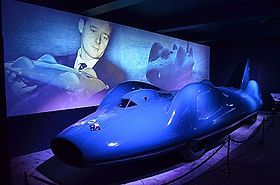| Bluebird-Proteus CN7 | |
|---|---|
 Bluebird today at Beaulieu | |
| Overview | |
| Manufacturer | Motor Panels[1] |
| Also called | Proteus-Bluebird Campbell–Norris 7 |
| Production | 1[1] |
| Designer | Ken Norris[1] |
| Body and chassis | |
| Body style | streamlined fully enclosed "turtle shell" |
| Layout | four-wheel drive centre engined |
| Powertrain | |
| Engine | A Bristol-Siddeley Proteus 705 free-turbine turboshaft) engine of 4,450 shp (3,320 kW)[1][failed verification] |
| Transmission | Front and rear drives to separate 3.6 to 1 spiral bevel gearboxes[1] |
| Dimensions | |
| Wheelbase | 13 ft 6 in (4.11 m)[1] |
| Length | 30 ft (9.1 m) [1] |
| Width | 5 ft 6 in (1.68 m) Track front and rear |
| Height | 4 ft 9 in (1.45 m) without the vertical fin, 7 ft 8 in (2.34 m) with fin[2] |
| Kerb weight | 8,064 lb (3,657.77 kg) – 8,960 lb (4,064.19 kg)[1] |
The Bluebird-Proteus CN7 is a gas turbine-powered vehicle that was driven by Donald Campbell and achieved the world land speed record on Lake Eyre in Australia on 17 July 1964. The vehicle set the FIA world record for the flying mile at 403.1 mph (648.7 km/h).